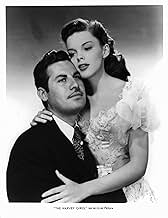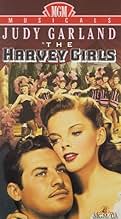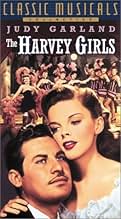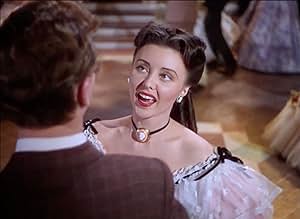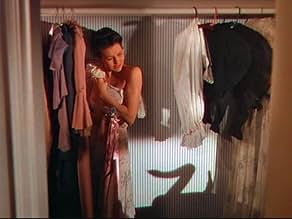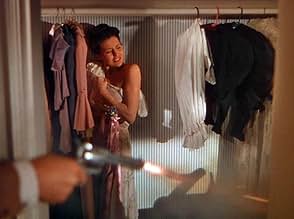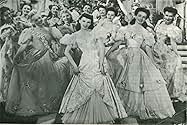AVALIAÇÃO DA IMDb
7,0/10
5,2 mil
SUA AVALIAÇÃO
Adicionar um enredo no seu idiomaOn a train trip West to become a mail-order bride, Susan Bradley meets a cheery crew of young women travelling out to open a "Harvey House" restaurant at a remote whistle-stop.On a train trip West to become a mail-order bride, Susan Bradley meets a cheery crew of young women travelling out to open a "Harvey House" restaurant at a remote whistle-stop.On a train trip West to become a mail-order bride, Susan Bradley meets a cheery crew of young women travelling out to open a "Harvey House" restaurant at a remote whistle-stop.
- Direção
- Roteiristas
- Artistas
- Ganhou 1 Oscar
- 4 vitórias e 1 indicação no total
William 'Bill' Phillips
- 1st Cowboy
- (as Wm. 'Bill' Phillips)
Avaliações em destaque
Ah...The Harvey Girls!
What can I say? In the mood for a little escapism? Do you enjoy classic Hollywood musicals? This MGM extravaganza is not to be missed!
Garland at her winsome best in material specifically tailored to her considerable talents - this is just before everything really started to sour in her professional life, and she never looked better. The material she's given to work with not only gives her the classic "Atchison, Topeka & the Santa Fe" to perform, but some wonderful comedic bits as well.
In the ensemble numbers, you can actually see her, as well as the rest of the cast, enjoying the moment as they filmed.
Beautifully photographed - a superb supporting cast who all get a moment to shine including Ray Bolger, Virginia O'brien, Marjorie Main, a very young Cyd Charisse and a stunning young Angela Lansbury.
MGM at the peak of it's creative and artistic powers - must see viewing for any fan of "The Golden Age" of Hollywood - check it out!
What can I say? In the mood for a little escapism? Do you enjoy classic Hollywood musicals? This MGM extravaganza is not to be missed!
Garland at her winsome best in material specifically tailored to her considerable talents - this is just before everything really started to sour in her professional life, and she never looked better. The material she's given to work with not only gives her the classic "Atchison, Topeka & the Santa Fe" to perform, but some wonderful comedic bits as well.
In the ensemble numbers, you can actually see her, as well as the rest of the cast, enjoying the moment as they filmed.
Beautifully photographed - a superb supporting cast who all get a moment to shine including Ray Bolger, Virginia O'brien, Marjorie Main, a very young Cyd Charisse and a stunning young Angela Lansbury.
MGM at the peak of it's creative and artistic powers - must see viewing for any fan of "The Golden Age" of Hollywood - check it out!
"The Harvey Girls" is a splendid example of a well-crafted Metro-Goldwyn-Mayer musical from a time when well-crafted musicals were being dished out in abundance from Metro's golden bowl.
Inspired by the revolutionary success of "Oklahoma" on Broadway and tailored to fit the protean talents of it's young leading lady, Judy Garland, the film tells the story, in words and music, of a group of waitresses brought west in the late 1800's to open another link in the Fred Harvey chain of restaurants. In the process, they encounter all kinds of romantic and dramatic conflicts. The cast is headed by Judy Garland, fresh from her triumph in the blockbuster musical "Meet Me In St. Louis" and her quietly moving dramatic performance in "The Clock". During the filming of "The Harvey Girls", Garland was one of the top box-office draws in the nation, and Hollywood's most versatile actress. She performs the role of Susan Bradley, an adventurous mail order bride who befriends the Harvey girls en route to New Mexico, with a vibrant comic touch. Her ability to combine tongue in cheek humor with her signature vulnerability is very satisfying in this film, and is an early highlight in her already legendary career.
The rest of the cast is first-rate: Angela Lansbury gives a wickedly fine performance as Em, the jaded dance-hall queen with hooded eyes and no-flies-on-me attitude. John Hodiak is the local tough guy and dance-hall owner, and also the object of Garland and Lansbury's affections. Broadway legend (and Garland's "Wizard of Oz" co-star) Ray Bolger does an amusing turn as the town's rubber legged blacksmith, and Preston Foster is the murderous Judge Purvis. The ranks of the Harvey girls are filled by some of Hollywood's most marvelous character actresses, including Marjorie Main and Virginia O'Brien, and the dancer Cyd Charisse in one of her first roles.
The film boasts what New York Times film critic Bosley Crowther appreciatively called "an abundance of chromatic spectacle and an uncommonly good score", the centerpiece of which is the Academy Award-winning song of the year (1946), "On The Atchison, Topeka, and the Santa Fe". This production number fills the screen with the colorful bustle of singers, dancers, and horses, and in the best Broadway tradition, advances the plot by introducing almost every cast member and giving them the opportunity to tell their story, in song, and their motivation for coming west in the first place. A spectacular bit of Golden Age musical magic, topped off by Garland's star turn entrance and full-throated belting of the Johnny Mercer/Harry Warren song.
The creative team behind this fable is as impressive as the talent in front of the camera. In addition to the score by Mercer and Warren, the film was directed by George Sidney ("Show Boat", "Annie Get Your Gun"), produced by Arthur Freed ("Singin In The Rain", "Gigi"), art directed by Cedric Gibbons ("The Great Zeigfeld", "The Wizard of Oz"), with musical direction by Lennie Hayton, orchestrations by Conrad Salinger, and musical arrangements by "Eloise" children's book author and singer Kay Thompson (a decade before she sizzled onscreen as the fashion magazine editor in the Audrey Hepburn classic "Funny Face").
This film will include restored Technicolor and stereo sound on DVD, and also a few musical numbers which were cut when the film was released due to length, and have been locked away in the MGM vaults. Now they have been restored, and the viewer can enjoy more of what film critic Howard Barnes called "a great big animated picture postcard."
Inspired by the revolutionary success of "Oklahoma" on Broadway and tailored to fit the protean talents of it's young leading lady, Judy Garland, the film tells the story, in words and music, of a group of waitresses brought west in the late 1800's to open another link in the Fred Harvey chain of restaurants. In the process, they encounter all kinds of romantic and dramatic conflicts. The cast is headed by Judy Garland, fresh from her triumph in the blockbuster musical "Meet Me In St. Louis" and her quietly moving dramatic performance in "The Clock". During the filming of "The Harvey Girls", Garland was one of the top box-office draws in the nation, and Hollywood's most versatile actress. She performs the role of Susan Bradley, an adventurous mail order bride who befriends the Harvey girls en route to New Mexico, with a vibrant comic touch. Her ability to combine tongue in cheek humor with her signature vulnerability is very satisfying in this film, and is an early highlight in her already legendary career.
The rest of the cast is first-rate: Angela Lansbury gives a wickedly fine performance as Em, the jaded dance-hall queen with hooded eyes and no-flies-on-me attitude. John Hodiak is the local tough guy and dance-hall owner, and also the object of Garland and Lansbury's affections. Broadway legend (and Garland's "Wizard of Oz" co-star) Ray Bolger does an amusing turn as the town's rubber legged blacksmith, and Preston Foster is the murderous Judge Purvis. The ranks of the Harvey girls are filled by some of Hollywood's most marvelous character actresses, including Marjorie Main and Virginia O'Brien, and the dancer Cyd Charisse in one of her first roles.
The film boasts what New York Times film critic Bosley Crowther appreciatively called "an abundance of chromatic spectacle and an uncommonly good score", the centerpiece of which is the Academy Award-winning song of the year (1946), "On The Atchison, Topeka, and the Santa Fe". This production number fills the screen with the colorful bustle of singers, dancers, and horses, and in the best Broadway tradition, advances the plot by introducing almost every cast member and giving them the opportunity to tell their story, in song, and their motivation for coming west in the first place. A spectacular bit of Golden Age musical magic, topped off by Garland's star turn entrance and full-throated belting of the Johnny Mercer/Harry Warren song.
The creative team behind this fable is as impressive as the talent in front of the camera. In addition to the score by Mercer and Warren, the film was directed by George Sidney ("Show Boat", "Annie Get Your Gun"), produced by Arthur Freed ("Singin In The Rain", "Gigi"), art directed by Cedric Gibbons ("The Great Zeigfeld", "The Wizard of Oz"), with musical direction by Lennie Hayton, orchestrations by Conrad Salinger, and musical arrangements by "Eloise" children's book author and singer Kay Thompson (a decade before she sizzled onscreen as the fashion magazine editor in the Audrey Hepburn classic "Funny Face").
This film will include restored Technicolor and stereo sound on DVD, and also a few musical numbers which were cut when the film was released due to length, and have been locked away in the MGM vaults. Now they have been restored, and the viewer can enjoy more of what film critic Howard Barnes called "a great big animated picture postcard."
The first person you see is Judy Garland singing an infinitely forgettable song.
For the most part it goes up from there.
This is a film that Vincente Minelly did not direct and even though it shows Judy at her demure best he had a knack for bringing out the best in her performances.
Surprisingly enough, this is not an entirely inaccurate history of the women that opened up the West -- just as much as the men did.
For those that do not know -- Fred Harvey was a railroad tycoon and visionary that realized that the United States could only expand Westward -- and he was there to help fulfill that dream.
His chain of "Railroad Hotels" (some of which still exist) and the women that staffed them, helped to civilize parts of the United States that were raw and uncultured.
This is one of those incredible films that has every face you have ever seen in a movie -- even if you do not always know their names: Ray Bolger, Preston Foster, Virginia O'Brien, John Hodiak, Angela Lansbury, Marjorie Main, Chill Wills and even Cyd Charisse.
This is cameo paradise and there is a character and face there for everyone.
The songs, the costumes, the sets and everything BUT the dialogue and story are top notch. But who needs a good script when you have a cast of STARS! (Especially Judy Garland.)
Take the good parts from this movie and try to pretend the rest never happened.
For the most part it goes up from there.
This is a film that Vincente Minelly did not direct and even though it shows Judy at her demure best he had a knack for bringing out the best in her performances.
Surprisingly enough, this is not an entirely inaccurate history of the women that opened up the West -- just as much as the men did.
For those that do not know -- Fred Harvey was a railroad tycoon and visionary that realized that the United States could only expand Westward -- and he was there to help fulfill that dream.
His chain of "Railroad Hotels" (some of which still exist) and the women that staffed them, helped to civilize parts of the United States that were raw and uncultured.
This is one of those incredible films that has every face you have ever seen in a movie -- even if you do not always know their names: Ray Bolger, Preston Foster, Virginia O'Brien, John Hodiak, Angela Lansbury, Marjorie Main, Chill Wills and even Cyd Charisse.
This is cameo paradise and there is a character and face there for everyone.
The songs, the costumes, the sets and everything BUT the dialogue and story are top notch. But who needs a good script when you have a cast of STARS! (Especially Judy Garland.)
Take the good parts from this movie and try to pretend the rest never happened.
Even though the film starred Judy Garland, what I really enjoyed about The Harvey Girls is that it operates as an ensemble musical, giving features and spotlight numbers to just about everyone in the mammoth cast. This kind of thing is usually reserved for stage musicals only, but back in 1946 MGM's roster of talent was strong, if not yet infamous. Players like deadpan comic Virginia O'Brien and dancer Cyd Charisse were fairly new back then, but this film gives them individual spotlights: not only do they both sing with Garland in the nighttime ballad "It's A Great Big World," but O'Brien gets to sing "The Wild, Wild West" (while assisting blacksmith Ray Bolger in shoeing a horse) and Charisse gets to dance (briefly) opposite Kenny Baker singing "Wait And See." Marjorie Main leads the Harvey waitresses through "The Train Must Be Fed;" Angela Lansbury is featured in two saloon numbers, and Ray Bolger gets to do some of his rubber-legged clowning at the Harvey House party. And, of course, everyone on the planet is assembled for the big, eight minute production number "On The Atchison, Topeka, and Santa Fe." There's literally something for everyone- even the oil-and-water romance between Garland and John Hodiak. And they shine as well, even if Hodiak wasn't the most well-known leading man. Check out this wonderfully scored, written, acted, and costumed tribute to old-fashioned Americana.
This works quite well as light entertainment. It has a good cast, with Judy Garland giving a lively performance in the lead role. The setting is rather stylized, but it is interesting, and it provides some good story material. The story has quite a few amusing moments, with just enough substance to keep it moving. There is also the top-notch "Atchison, Topeka, & the Santa Fe" number, which would almost make a musical worth watching all by itself.
The story of the conflict between the "Harvey Girls" and their rivals across the road is sometimes a little exaggerated, but it is relatively interesting and it makes for some good sequences. The female cast members get most of the best moments, and they generally use them well. Angela Lansbury seems quite natural as Garland's disagreeable nemesis, Virginia O'Brien has some good lines, and Marjorie Main is quite lively. There's more than enough to make it an enjoyable, if light, feature.
The story of the conflict between the "Harvey Girls" and their rivals across the road is sometimes a little exaggerated, but it is relatively interesting and it makes for some good sequences. The female cast members get most of the best moments, and they generally use them well. Angela Lansbury seems quite natural as Garland's disagreeable nemesis, Virginia O'Brien has some good lines, and Marjorie Main is quite lively. There's more than enough to make it an enjoyable, if light, feature.
Você sabia?
- CuriosidadesIn the big production number "On the Atchison, Topeka and the Santa Fe," from Judy Garland's entrance until the conductor's "All aboard!" was done in one take. Legend has it that they shot it twice and Garland was dead-on move for move both times.
- Erros de gravaçãoIn the "Wild, Wild West" song, Alma is pounding a red-hot horseshoe. She then picks it up, caresses it, and throws it in the water barrel where it gives off steam. The horseshoe would have burned her hand if it were really hot. This is a sight gag in the film.
- ConexõesFeatured in MGM Parade: Episode #1.25 (1955)
- Trilhas sonorasIn the Valley (Where the Evenin' Sun Goes Down)
(uncredited)
Music by Harry Warren
Lyrics by Johnny Mercer
Performed by Judy Garland
Principais escolhas
Faça login para avaliar e ver a lista de recomendações personalizadas
- How long is The Harvey Girls?Fornecido pela Alexa
Detalhes
- Data de lançamento
- País de origem
- Idioma
- Também conhecido como
- Las chicas de Harvey
- Locações de filme
- Empresa de produção
- Consulte mais créditos da empresa na IMDbPro
Bilheteria
- Orçamento
- US$ 2.524.315 (estimativa)
- Faturamento bruto mundial
- US$ 1.417
- Tempo de duração1 hora 42 minutos
- Proporção
- 1.37 : 1
Contribua para esta página
Sugerir uma alteração ou adicionar conteúdo ausente


